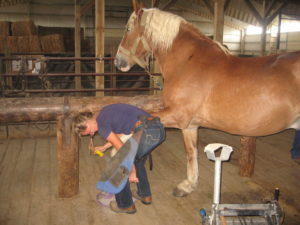Farrier’s Promote Animal Welfare
Competent farriers are sometimes unfairly accused of inflicting pain on horses simply because the nature of their work. Not all farriers are the same. Some may be justly criticized for causing pain. An occasional sadist might pop up and too often we see farriers and trimmers alike harming horses out of ignorance. But these are exceptions. As a rule, farriers are animal welfare promoters. Like doctors and veterinarians we observe the Hippocratic Oath to first, do no harm. Hopefully, farriers get into this business because of their love for horses.
There is a difference between animal welfare and animal rights. According to the American Veterinary Medical Association, animal welfare is defined as a “human responsibility that encompasses all aspects of animal well-being, including proper housing, management, disease prevention and treatment, responsible care, humane handling, and, when necessary, humane euthanasia” (avma.org). Those who advocate animal rights, hold a more extreme view that animals have rights similar to or just like humans and that “animals are not ours to use for food, clothing, entertainment, or experimentation” (peta.org).
In today’s world, the line between animal welfare and animal rights is becoming increasingly blurred. I believe that while it is very important to care for animals and be good stewards over them, we shouldn’t forget that they are still animals. A study done in 2013, asked participants to answer this dilemma: “A bus is traveling down a busy street. Your pet runs out in front of the bus. Unfortunately, at the same time a foreign tourist steps out in front of the bus. Neither your pet nor the foreign tourist has enough time to get out of the way of the bus. It is clear, given the speed of the bus, it will kill whichever one it hits. You only have time to save one. Who would you save?” An alarming 40% said they would save the life of a pet over the life of a (human) stranger (Stanley Coren, PhD, DSc, FRSC, Psychology Today, August 2013).
Vicki Hearne explains in her exceptional essay, What’s Wrong with Animal Rights, that animal rightists confuse “rights” with “unnecessary suffering.” (Harper’s Magazine, September 1991) Most animal rights literature is based on the premise that animals should not suffer. As animal welfarists, we are in total agreement! Yet the animal rights movement goes further, seeking to limit human involvement. According to them, horses should not be made to barrel race or jump or learn complex dressage routines. This has an opposite effect. Instead of affording the animal a right—the right to excel at what it naturally enjoys—animal rightists actually limit the animal’s rights by seeking to pass laws that restrict what they naturally get pleasure from. Hearne says, “Happiness for Secretariat [was] in his ebullient bound, that joyful length of stride.” Anyone who has worked with precision trained animals understands that statement.
As animal welfarists, farriers seek to help the horse achieve that level of precision and happiness. Note that the farrier’s job is not to make the horse do anything. This is nearly impossible anyway. On occasion, we have been asked, “Can you put sliding plates on my horse so she will slide?” Of course, the answer is no. The horse will only slide when she has been through the proper training. On the other hand, a horse that is already an accomplished slider may become more efficient when a knowledgeable farrier fits the proper shoes. Often when this happens, the horse, upon realizing its improvement, displays satisfaction. Those who are attuned to reading the horse’s body language can tell the horse likes it.
In order to be true animal welfarists, farriers need to not only understand how to do the job but they should also understand what they do and why they do it. Sometimes, the farrier’s job may be a minimal amount of involvement—just trimming the horse in balance—and then getting out of the way so the horse can do its job. Other times more technical shoes or procedures may be necessary to aid the animal. The goal should always be to accommodate, never to inhibit. In every case, farriers should evaluate the individual horse’s situation and ask themselves, “How can I help?” Then we can truly help our horse companions have more fulfilling lives.
Related Posts
-
A serious affliction of horses today is laminitis and founde...Oct 26, 2017 / 0 comments
-
“Doug, I attended your Horse Expo seminar this past Ma...Apr 22, 2010 / 0 comments
-
Happy New Year! The New Year brings with it a determination ...Jan 30, 2015 / 0 comments
Blog Categories
- Anatomy
- Best Business Practices
- Conformation
- Current Events
- Customer Service
- Draft Horse Shoeing
- Equine Soundness
- Essential Anatomy Kit
- Farrier Careers
- Farrier training
- Foal soundness
- Horse Care
- Horse Foot Care
- Horse Owner Tips
- Horsemanship
- Horseshoeing
- Horseshoeing History
- Iron and Forge Work
- Student Spotlight
- Uncategorized
- Veterinary Care
Blog Archives
Contact Us
Butler Professional Horseshoeing School
495 Table Road
Crawford, NE 69339
(800) 728-3826
jacob@dougbutler.com
Subscribe to Our Blog
Get Our Free e-Book!
If you think you want to become a farrier (or know someone who does), this book can help you make that decision. Horse owners will learn the importance of choosing a qualified farrier and how to select the “right” one.
[ Get the e-Book Now! ]
- Follow:

